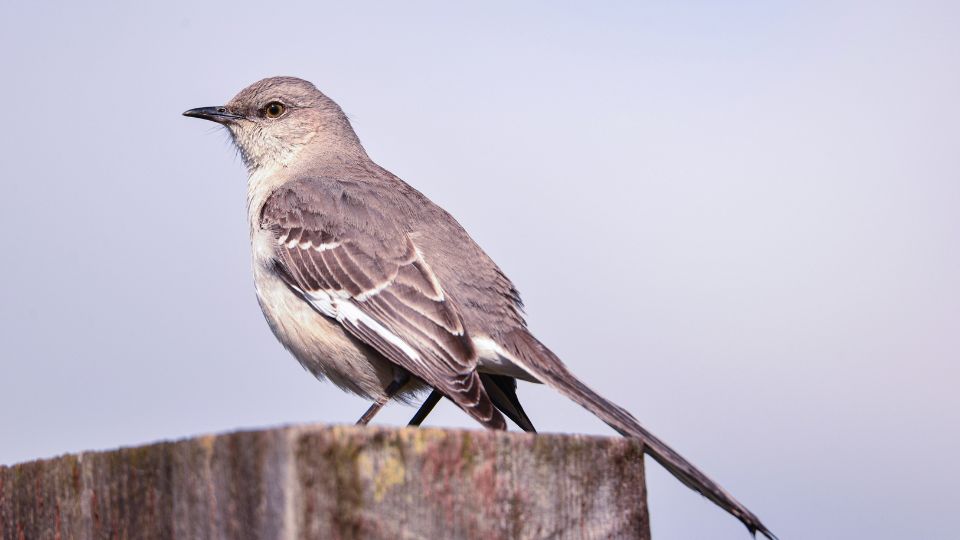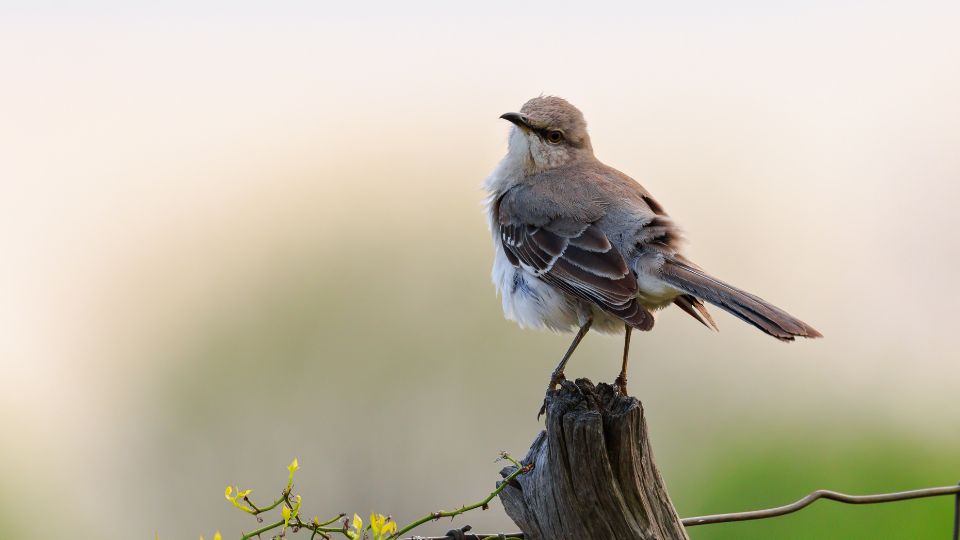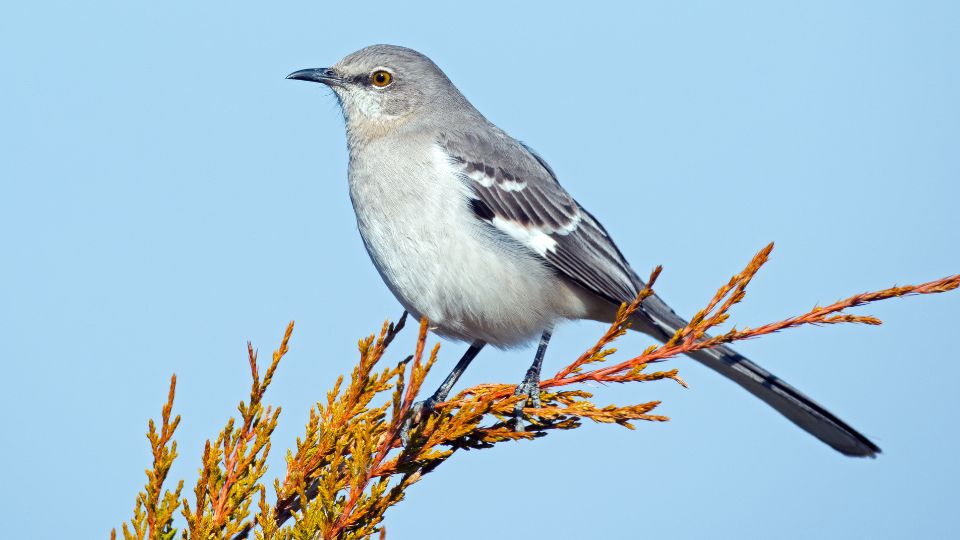Mockingbirds are a descendant bird of the Passeriformes order, known as the Mimidae family. There are a total of 17 types of mockingbirds subspecies. The mockingbirds' vocal capabilities include mimicking the sounds of other songbirds, animals, and even outdoor sounds.
Mockingbirds have a small and slender frame with equally dull feathers. While they look like simple and unassuming birds, they have interesting personalities! So interesting that they are the state bird of five states in the US.
In the early 1900s, the Mockingbird was only found in southern portions of the United States. Today, they are found all over the continental United States and even in parts of Canada and Mexico. Let’s dive into what makes the Mockingbird so special.
What Does A Mockingbird Look Like?
Mockingbirds aren’t overly flashy. They have an overall brownish-gray coloring with lighter tones on their breast. They have short and stout wings with white wing patches that, while in flight, make their tail feathers look very long.

The Northern Mockingbird
The Northern mockingbird can be found in most of North America, occasionally migrating southward when inclement weather emerges. This subspecies has a grayish backside with the white underbelly and measures 8.2-10 inches with a 12 to 14 inches wingspan.
The wings are typically gray with white tips. This medium-sized bird has a similar shape and structure to the American Robin.

The Tropical Mockingbird
This mockingbird is a resident of tropical areas such as southern Mexico, South America, and even some Caribbean islands. Notable features of this subspecies include a gradient grayish to backside and wingspan with a whitish underbelly.
The tropical mockingbird does not have the notable white patches that the Northern Mockingbird has on its wings, and the two species migration ranges do not overlap.
Other Mockingbird Species include:
- Mimid
- Gray catbird
- Brown thrasher
- Bahama mockingbird
- Blue mockingbird
- Melanotis
- Curve-billed thrasher
- Socorro mockingbird
- Chalk-browed mockingbird
- Brown-backed mockingbird
- Hood mockingbird
- California thrasher
- Townsend’s solitaire
- Northern shrike
- Floreana Mockingbird
- San Cristobal Mockingbird
- Blue-and-white mockingbird
- Long-tailed mockingbird
- Patagonian mockingbird
- Chilean mockingbird
- White-banded mockingbird
- Galápagos mockingbird
- Blue-gray gnatcatcher
- Wood thrush
Where Do Mockingbirds Live?
While Mockingbirds lived primarily in the southern portion of the United States in the early 1900s, they are found in most parts of North America today. They live in dense thickets along the edges of forests and can be spotted in some residential neighborhoods.
The Mockingbird is the state bird in many southern states in the US, including Arkansas, Florida, Mississippi, Tennessee, and Texas. Texas, for example, selected the Mockingbird as the state bird because it is fiercely territorial and protects its home at all costs.
Where Mockingbirds Make Their Nests
The Northern Mockingbird makes its nest in tree shrubs around 8-10 feet off of the ground.
During the breeding season, the male Mockingbird makes a few nests, and the female Mockingbird selects one of the nests to raise her broods.
Nestlings remain in the 12 days after hatching. Baby Mockingbirds are taught to fly and forage for food from the male while the female is busy building another nest. Throughout a single breeding season, Mockingbirds typically raise between two and four broods of baby birds.
What Does A Mockingbird Sound Like?
Mockingbirds can imitate up to 200 sounds and are often sounds that they hear in their environment.
These sounds are often the songs of other songbirds, but sometimes they can also be the sounds of car alarms or creaky iron gates.
Ornithology researchers believe that male Mockingbirds that imitate the most songs are likelier to snag a female Mockingbird. They imitate birds like Cardinals, Finches, Blue Jays, and the Eastern Bluebird. Mockingbirds that mimic more birds often have a larger territory than mockingbirds with a limited range of imitations.
While they primarily imitate other birds, they also have a few songs of their own. Their unique song is a series of sounds, including buzzing, whirrs, and warbles.

How Can I Attract Mockingbirds To My Yard?
To attract Mockingbirds to your yard, you need to understand what they like to eat most. This North American bird is an omnivore, which means they eat things like wasps, bees, and crickets in the summer and switch to something like fruit in the cooler months when insects aren’t as abundant.
If you want to attract these songbirds to your yard, they aren’t as attracted to wild songbird seed mixes. Songbird birdseed is excellent for birds like finches, but the Mockingbird isn’t as impressed.
Suet, however, is a different story. To attract Mockingbirds to your backyard feeders, a suet feeder is a great way to draw them into your yard. Opt for suet feeders with mealworm cakes to give them much-needed protein in the cooler months.
You can also lay out fresh fruit to attract them to your yard. Also, planting Mockingbird-loving berry bushes like blackberry, blackberry, pokeweed, and juniper are great options to transform your backyard space into a Mockingbird-friendly habitat.
What is the Significance of Mockingbirds?
Threatened Mockingbirds protect their home with a fierce resolve that proves they defend what they love at all costs.
It’s their love and protection of their family, married with their innocence and mimicry, that makes this bird so beloved.
Fun Facts About Mockingbirds
Mockingbirds never stop singing. They take their mating calls seriously and continue to sing well into the night. If a male Mockingbird still hasn’t found a mate, he will burn the midnight oil desperately to find a female Mockingbird.
The Latin name of a Mockingbird is Mimus polyglottos, which translates to ‘many tongued mimic.’ They can mimic over 200 different sounds and songs including noises heard from car alarms and sirens.
Mockingbirds take breeding season very seriously. During the breeding season, a male Mockingbird can attempt up to 7 broods in a single season. There have been sightings that a single female Mockingbird once laid up to 27 eggs in a single breeding season!
Mockingbirds don’t like anyone encroaching on their territories, including humans! If they feel their nest (or preferred food source) is threatened, they’ll swoop down in a fury to chase the treat away.
In the video below, we rounded more fascinating facts about Mockingbirds!
How To Spot A Mockingbird
White Mockingbirds are found in much of North America; spotting them is difficult. Their appearance is small and petite, and their brown feathers make them hard to spot. They are often confused with the Loggerhead Shrike, which has a similar shape and color. The Loggerhead Shrike, however, has black plumage compared to the Northern Mockingbird.
Another easy way to find a Mockingbird is to listen to their songs. While they often mimic the songs of other birds, they repeat them in rapid succession in high-pitched and very loud notes. Unlike other birds,
Mockbirds don’t stop singing when the sun goes down. If you hear a bird singing in the middle of the night, odds are it is a Mockingbird!

